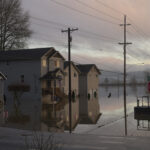A federal judge who has been critical of PG&E Corp.’s safety record said the utility has a “clear-cut pattern” of starting fires.
U.S. District Court Judge William Alsup is overseeing PG&E’s probation for safety violations that led to felony convictions for the 2010 explosion of one of its gas pipelines, which killed eight people. He has proposed strict protocols for California’s largest utility following a series of massive fires along its 125,000 miles of power lines over the past two years.
“Usually a criminal on probation is forthcoming and admits what they need to admit. You haven’t admitted much,” Alsup told lawyers for the company at a hearing Wednesday in federal court in San Francisco. “There’s a clear-cut pattern here: that PG&E is starting these fires.”
“Does the judge just turn a blind eye and say, ‘PG&E, continue business as usual, continue to kill people’?” Alsup asked.
Earlier in the hearing Wednesday, Alsup concluded PG&E violated its probation by not telling its monitor details about the investigation and resolution of the 2017 Honey fire. The judge said he’ll set a sentencing date for that later.
Among other suggestions, the judge proposed subjecting the company to criminal sanctions if it failed to shut off electric supply to portions of the grid on extremely windy days, trim tree branches and inspect and repair thousands of miles of power lines. PG&E says the billions of dollars in liabilities from the blazes drove it to file bankruptcy Jan. 29.
Alsup scheduled the hearing to give PG&E a chance to argue against the judge’s fire safety measures as well as the probation issue.
PG&E Judge Wants All Dangerous Trees Trimmed Before 2019 Fires
PG&E accepts trees are the leading cause of fires PG&E was found to have caused, the company’s lawyer, Kevin Orsini, said at the hearing. The utility “accepts the proposition that something more needs to be done,” Orsini said.
Alsup suggested an order requiring PG&E to trim more branches could help the company override resistance from landowners who Orsini said don’t want the company cutting trees. He also resisted the company’s assertion that there weren’t enough tree trimmers to implement the proposals.
“I don’t believe you’ve exhausted the supply of people who know what they’re doing,” Alsup said. The California Department of Forestry and Fire Protection, or CalFire, could lend its workers in the winter when it’s not fighting fires, Alsup said.
Orsini told the judge he understands his skepticism. “We don’t need an order because we’re doing it right now,” he said, referring to risk mitigation measures.
All eyes are on Alsup because while the Chapter 11 filing freezes and relegates lawsuits brought by victims of the wildfires, the judge is overseeing a criminal case unaffected by the restructuring.
The case is important to investors of PG&E, whose shares are expected to continue trading for the duration of the company’s reorganization.
Alsup’s decisions will be a focus of regulators, ratepayers and Californians for whom the fires – burning thousands of acres, filling large swaths of sky with toxic smoke and claiming property and lost lives – are becoming an annual event.
Some experts have lauded him for taking on the role of “super regulator.” But in the days leading up to the bankruptcy, Alsup also was criticized by regulators and the utility itself, which said his measures could cost as much as $150 billion.
The strongest objection came from an electrical workers union, which in an unsolicited Jan. 25 court filing said its members offered “superior, direct, first-hand knowledge of PG&E’s grid.”
“The goal of reducing ‘to zero the number of wildfires caused by PG&E in the 2019 season’ is noble but not practical,” the union said. “The incidents that led to the 2017 and 2018 wildfires were minor failures that happen every day in every utility. An electric utility does not operate in a laboratory and perfection is not possible.”
Inspecting 2.3 million electrical distribution poles and 150,000 transmission structures across 125,000 miles of power lines by June, as Alsup suggested, “is not a realistic or pragmatic idea,” the union said. “In fact, it is not possible.”
The case is U.S. v. Pacific Gas and Electric Co., 14-cr-00175, U.S. District Court, Northern District of California (San Francisco).
Was this article valuable?
Here are more articles you may enjoy.

 Marijuana’s Move to Schedule III: What it Really Means for Cannabis Insurance
Marijuana’s Move to Schedule III: What it Really Means for Cannabis Insurance  Trump Sues BBC for $10 Billion Over Documentary Edit
Trump Sues BBC for $10 Billion Over Documentary Edit  Pacific Northwest Braces for Even More Flooding Rain This Week
Pacific Northwest Braces for Even More Flooding Rain This Week  Atmospheric River to Flood Pacific Northwest Through Week
Atmospheric River to Flood Pacific Northwest Through Week 